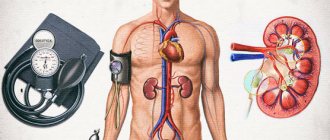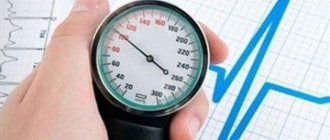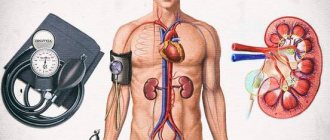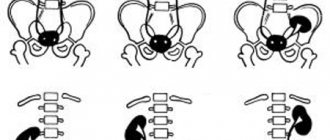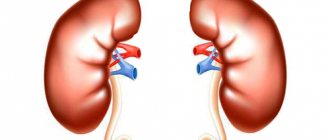Arterial hypertension or high blood pressure is a serious reason to contact a specialist.
It is this pathological condition, in addition to a number of painful symptoms, that can cause severe complications that pose a threat to the normal functioning of the body.
Consequences of hypertension, such as heart attack, stroke, or ruptured aortic aneurysm, are among the leading causes of death in cardiac hospitals around the world.
Therefore, timely diagnosis of high blood pressure with determination of the causes of the disease allows one to select adequate therapy to correct the underlying disease and prevent its complications.
How the adrenal glands affect blood pressure
The cortex of the adrenal glands produces cortisol and aldosterone, and the cells of the medulla produce adrenaline, norepinephrine and dopamine - all of these hormones predominantly increase blood pressure levels.
We recommend reading the article on how to test your adrenal glands. From it you will learn about the reasons for examination, which doctor to see, how to check the structure of the adrenal cortex and what diseases can be detected.
And here is more about the adrenal glands and excess weight.
Cortisol is the main adrenal hormone that increases blood pressure
Normally, this hormone has a regulating effect on blood circulation indicators: it dilates the vessels of the heart and brain, ensuring the flow of blood to them, improves the nutrition of muscle tissue, increases cardiac output, and speeds up the rhythm of contractions.
With excessive secretion of cortisol by the adrenal cortex, patients develop arterial hypertension - high blood pressure . At first, the systolic indicator increases mainly, and then the diastolic one.
High blood pressure numbers are recorded periodically at an early stage. Then hypertension becomes constant and tends to progress regardless of gender, age and even the concentration of cortisol itself in the blood .
This is explained by the fact that a persistent excess of the hormone:
- activates the formation of angiotensinogen in the liver (it is then converted into angiotensin 2, which causes arterial spasm);
- disrupts the ability of blood vessels to relax;
- stimulates the sympathetic nervous system;
- inhibits the synthesis of substances that expand the lumen of the arteries.
Adrenal aldosterone and blood pressure
The adrenal hormone aldosterone inhibits the excretion of sodium by the kidney tubules, while water is retained in the vascular bed, which increases blood pressure. Recent studies have proven that this is not the only mechanism of persistent hypertension under the influence of aldosterone. It also increases the flow of sympathetic impulses that spasm the arterial branches, directly constricts the blood vessels, and increases peripheral resistance.
In patients with excess aldosterone in the blood, arterial hypertension has a severe course, often leading to acute circulatory disorders in the myocardium (infarction), brain tissue (stroke), decreased vision (retinopathy), and kidney damage. When using any antihypertensive drugs, blood pressure does not decrease. Only Veroshpiron or Inspra can help.
Adrenal catecholamines and high blood pressure
Adrenaline and norepinephrine are adrenal hormones that act on adrenergic receptors in the vascular wall and heart muscle, and dopamine also acts on the corresponding dopamine receptors - the result of the complex and sometimes multidirectional actions of catecholamines is an increase in pressure and spasm of arterial vessels.
Hypertension with an excess of these hormones often has a crisis course with an increase in systolic reading to 250 or more units, with panic attacks, autonomic reactions (sweating, hand tremors), tachycardia.
Symptoms of secondary hypertension
Symptoms that characterize high blood pressure due to the adrenal glands include the following:
- is insensitive to standard therapy with conventional antihypertensive drugs effective for primary arterial hypertension;
- combined with signs of dysfunction of the adrenal glands, namely the appearance of red stretch marks on the lateral surfaces of the torso and thighs, poor health, gradual deterioration of memory, partial loss of performance, prolonged headaches;
- occurs predominantly in young patients (sometimes in childhood) and is characterized by high rates that are unusual for ordinary hypertension;
- if the pressure decreases during periods of remission of symptoms of adrenal disease.
Having suspected secondary hypertension, the doctor must make sure that the patient with high blood pressure is actually taking antihypertensive medications regularly and according to the regimen, but to no avail.
Some patients mistakenly believe that during therapy, if the blood pressure is not elevated, pills should not be taken. Such behavior provokes an exacerbation of hypertension, which can push a specialist to false conclusions regarding the person’s condition.
In any case, specialists suggest that all patients with high blood pressure undergo a comprehensive examination and visit an endocrinologist.
It is he who is able to conduct a competent examination of the adrenal glands in case of hypertension, which will confirm or exclude the presence of secondary arterial hypertension of endocrine origin in a person.
An endocrinological consultation specialist will offer his vision of treating the disease, based on the characteristics of the underlying disease, the degree of its neglect and the presence of complications from the endocrine glands.
Diseases of the adrenal glands with increased, high blood pressure
Excessive release of adrenal hormones in connection with diseases leads to symptomatic arterial hypertension, they are presented in the table.
| Name of the disease | Manifestations |
| Itsenko-Cushing's syndrome and disease | Excess cortisol appears with a tumor (adenoma) of the pituitary gland, adrenal glands (corticosteroma, glucosteroma, adenocarcinoma), when using Hydrocortisone, Prednisolone or their analogues for treatment. Accompanied by obesity, diabetes, osteoporosis, and sexual dysfunction. |
| Hyperaldosteronism | It happens with nodular growth of the cortex or the appearance of a tumor that produces aldosterone. In addition to hypertension, patients experience progressive muscle weakness, arrhythmia, decreased vision, seizures, and numbness of the extremities. |
| Pheochromocytoma | Hormonally active tumor of the medulla, predominantly of hereditary origin. Most often it occurs with crises; they can be provoked by stress, overheating, physical activity, alcohol intake, and certain medications. |
Diseases leading to low blood pressure
Among the diseases of the adrenal glands that lead to a decrease in blood pressure, the most famous is Addison's disease (adrenal cortical insufficiency, primary hypocortisolism), when, for a number of reasons, the cortical layer is destroyed and adrenal hormones are produced in minimal quantities or are absent altogether.
Typical symptoms of the disease:
- increased pigmentation of the skin and mucous membranes;
- weight loss (due to gradual dehydration);
- decreased libido, asthenia;
- general weakness, increased fatigue;
- hypotension;
- digestive disorders - nausea, vomiting, constipation, diarrhea, loss of appetite, abdominal pain,
- addiction to salty foods.
The disease often occurs in the form of Addisonian crises:
- cardiovascular – cyanosis of the fingertips, nose, ears (acrocyanosis), coldness of the extremities, pale face, thready pulse, tachycardia, fainting;
- gastrointestinal - resembles a picture of acute abdomen or food poisoning (flatulence, nausea, loose stools, uncontrollable vomiting, cramping pain);
- neuropsychic – convulsions, meningeal symptoms, headache, lethargy, delirium, stupor.
Adrenal glands and low blood pressure
Hypotension (low blood pressure) is one of the early and persistent signs of adrenal insufficiency; it can be caused by:
- autoimmune diseases;
- tuberculosis;
- genetic abnormalities;
- tumor metastases from other organs;
- hemorrhage;
- infections - syphilis, fungi, suppuration;
- consequences of treatment - adrenalectomy (removal of the adrenal gland), radiation;
- lesions of the pituitary gland and hypothalamus.
Accompanied by loss of body weight, darkening of the skin, general weakness, lethargy. Low blood pressure leads to dizziness, darkening of the eyes, especially when changing body position, and fainting. As a crisis develops, consciousness may be impaired to varying degrees of severity.
Hypersecretion of II-deoxycorticosterone
One of the causes of endocrine adrenal hypertension is the perverted production of 11-deoxycorticosterone. This substance is a precursor to the hormone cortisol. When enzymes malfunction, there is a failure in converting it into cortisol.
A large amount of accumulated 11-deoxycorticosterone leads to sodium retention, increased urinary potassium excretion, increased circulating blood volume and increased blood pressure. This pathology is a hypertensive form of CAH (associated with gene mutation).
When examining patients, an increase in levels of adrenal androgens in the blood serum and an increase in 17-ketosteroids in the urine are revealed. Treatment is carried out with the help of glucocorticoid hormones - hydrocortisone, prednisolone, dexamethasone.
Blood pressure medications for adrenal adenoma
Adrenal cortical adenoma can produce aldosterone or cortisol, which increases blood pressure, and medications do not help. To treat it, an operation is performed - adrenalectomy, which allows the patient to be relieved of arterial hypertension and its consequences. Typically, drug therapy is not effective enough, since while the formation of hormones is enhanced, the pressure remains persistently elevated.
At the stage of preoperative preparation or for patients with absolute contraindications to surgery, the following is prescribed:
- aldosteroma - Veroshpiron, Eplerenone, they block aldosterone receptors;
- familial form of hyperaldosteronism - Dexamethasone is indicated, it helps to normalize the activity of the renin-angiotensin-aldosterone system;
- corticosteroma – inhibitors of the formation of steroid hormones Mitotan, Orimeten.
These drugs are often combined with alpha blockers (Ebrantil, Zoxon), combined adrenergic blockers (Carvedilol), angiotensin-converting enzyme inhibitors (Hartil, Moex), angiotensin 2 antagonists (Vasar, Micardis), diuretics (Arifon, Lasix).
We recommend reading the article about adrenal diseases. From it you will learn what diseases of the adrenal glands can be, the reasons for their occurrence, symptoms in children, women and men, tests for detection.
And here you can read more about the consequences of removing the adrenal glands.
Blood pressure in adrenal diseases depends on the level of cortisol, aldosterone and catecholamines. With their excessive formation, symptomatic hypertension develops, resistant to the action of most antihypertensive drugs.
Since the most common cause of high blood pressure is a tumor, its removal is recommended. Conservative treatment of adrenal adenoma is carried out in preparation for surgery. Hypotension is a sign of adrenal insufficiency.
Diagnostic methods
Hypertension is diagnosed based on laboratory and instrumental diagnostic techniques:
Echocardiography helps diagnose the disease.
- Hormonal panel. The level of hormones in the blood is examined. Attention is paid to catecholamines, gluco- and mineralocorticoids.
- Study of the concentration of hormonal substances in urine.
- Tonometry. Systolic and diastolic values in both arms are measured and compared.
- Electrocardiography. This instrumental method is used to exclude cardiac pathology.
- Echocardiography.
- Bicycle ergometry. This physical technique is recommended to establish the dependence of symptoms on physical activity.
Useful video
Watch the video about high blood pressure and the adrenal glands:
Similar articles
- How to test the adrenal glands, what tests to take...
There are several basic methods for testing the adrenal glands. For example, take a blood test for hormones for women and men. Cortical function may need to be tested in the child. Which doctor refers you for tests? Read more - Removal of the adrenal gland: consequences for the body...
In some situations, the adrenal gland must be removed, which will have consequences for the body of women and men. They may appear immediately or in the long term, even if there was an operation to remove the adenoma. Read more
- Drugs for the adrenal glands: which ones are used for...
Both in case of impaired production and in order to suppress excessive production, drugs for the adrenal glands are prescribed. They are also used to treat obesity in women. There are medications to normalize the functioning of the adrenal glands, as well as stop the progression of pheochromocytoma. Read more
- Adrenal glands and excess weight: how obesity is connected...
Of course, adrenal glands and excess weight are inseparable companions. After all, organs produce hormones that stimulate the accumulation of fat in the body. Which adrenal hormones cause excess weight? Read more
- Adrenal gland diseases: causes in women, men...
Unfortunately, adrenal diseases are not always detected in a timely manner. More often they are found as congenital in children. The reasons may also be due to hyperfunction of the organ. Symptoms in women and men are generally similar. Tests will help identify diseases. Read more
Hypertensive crises
A hypertensive crisis (a sharp increase in blood pressure) is accompanied by headaches, dizziness, nausea and vomiting, and rapid heartbeat. Pain in the heart occurs, the attack is accompanied by trembling, increased sweating, and a feeling of dryness in the mouth. An attack of a hypertensive crisis is sudden and can be triggered by the consumption of contraindicated alcoholic beverages, a sharp deterioration in a person’s psycho-emotional state, or overexertion during physical activity. The thought of imminent death can aggravate the attack. The duration of its occurrence can vary from several minutes to hours.
After an attack, there is general lethargy of the body, but the pressure, as a rule, stabilizes to the individual norm. But the course of a crisis in a severe form is dangerous due to complications and possible hemorrhages, which can lead to a stroke (mini-stroke), heart failure, and swelling of the abdominal organs.
Hypercortisolism
This condition includes Itsenko-Cushing's disease, a severe disorder of neuroendocrine regulation, leading to bilateral enlargement of the adrenal cortex. Overproduction of corticosteroids (cortisol) by the adrenal glands is the cause of endocrine hypertension.
Cortisol ensures a person’s adaptation to stress factors; its production by the adrenal glands is stimulated by another hormonal organ - the pituitary gland through adrenocorticotropic hormone (ACTH).
The production of this hormone increases against the background of a microadenoma (benign tumor) in the pituitary gland. ACTH constantly forces the adrenal cortex to work, as a result of which it hypertrophies.
Hypercortism may be a consequence of Itsenko-Cushing syndrome, which develops as a result of long-term use of glucocorticoid hormones or the occurrence of a tumor in the adrenal cortex.
Arterial hypertension in this pathology is moderate, but its prolonged existence leads to vascular disorders.
- Disproportionate obesity;
- Arterial hypertension;
- Muscular atrophy of the limbs;
- Moon-shaped face;
- Purple stretch marks on the body;
- Osteoporosis;
- Mental disorders;
- Thirst;
- Increased blood glucose levels;
- Heart failure;
- Excessive hair growth.
Hypercortisolism is supported by increased levels of cortisol and ACTH in the blood, 17-OX and free cortisol in the urine per day, and a high dexamethasone test.
Treatment
Endocrine hypertension with hypercortisolism can be treated with conventional therapy, but without tumor removal, the severity of the patient’s condition increases. When a clear localization of the pituitary microadenoma is determined, a neurosurgical operation is performed in a specialized hospital. Recovery occurs in 80% of cases, but relapse may occur.
Replacement therapy is carried out for a short time. If it is not possible to determine the tumor, proton therapy is recommended for the pituitary gland and simultaneous removal of one adrenal gland. Neoplasms (adrenales) are removed surgically and short-term replacement therapy is carried out.
The main drug treatment for Cushing's disease is the prescription of drugs that suppress the production of ACTH and blockers of corticosteroid production. Against this background, it is additionally recommended:
- Vitamins, potassium preparations;
- Antihypertensives – ACE inhibitors;
- Spironolactone;
- Osteoporosis is treated.
In severe cases of the disease, both adrenal glands are removed, followed by lifelong replacement therapy with glucomineralocorticoids. All patients require long-term observation by an endocrinologist, therapist, or neurologist.
Why do hormones cause hypertension?
A number of hormonal molecules have a tropic effect on receptors of blood vessels and the heart. Adrenaline secreted by the adrenal cortex acts on the myocardium. It increases cardiac output and increases heart rate. Norepinephrine, which is also produced in the adrenal cortex, affects blood vessels. The latter have specific adrenergic receptors, the configuration of which allows hormones to attach to them and activate them. HA and other molecules work on a similar principle.
Causes of the disease
Currently, it is difficult to establish the causes of the cyst. We can say with complete confidence that pathology occurs when the embryo is still in the body of a pregnant woman. After birth, the disease develops at a slow pace, the patient is unaware of the occurrence of a cyst. In most cases, the patient does not experience any inconvenience, but, in turn, the disease causes considerable harm to the body, so it should be treated.
To accurately diagnose the disease, the patient needs to undergo a full comprehensive examination. The patient is tested to determine hormonal levels, undergoes X-rays and mandatory computed tomography. To exclude malignancy, contrast-enhanced tomography is performed to identify possible metastases. Additional examinations also include ultrasound of the adrenal glands, general urine test, ECG and blood test.
A cyst on the left or right organ is sometimes difficult to identify due to its dense adherence to the surface of the gland. Magnetic resonance imaging is used to more accurately diagnose the disease.
During pregnancy, gynecologists often use ultrasound to examine the fetus for pathologies. Even at the earliest stage it is possible to detect the occurrence of changes or dysfunction of the adrenal glands.
After the baby is born, the baby is examined and weighed. If biochemical tests do not reveal any abnormalities, then sonography is used. If a cyst is detected, the child will need to undergo periodic examinations to monitor changes in its size. Thanks to examinations, it is possible to find out whether the cyst is enlarging or not, whether treatment or surgery is required or not.
Treatment
Treatment of high or low blood pressure associated with adrenal diseases is complex. It includes:
- symptomatic therapy - drugs that reduce/increase blood pressure, preserve calcium in the bones, reduce blood glucose levels, relieve headaches, etc.;
- maintenance therapy with missing hormones or, conversely, drugs that neutralize their excessive effects;
- elimination of the cause of the disease (etiotropic therapy), if possible - removal of the hormone-producing adrenal tumor.
Most adrenal diseases that cause high blood pressure occur over a period of time. Therefore, symptoms increase gradually. In these cases, it is quite difficult to identify the true nature of hypertension. As a rule, the lack of effect with standard regimens of antihypertensive drugs and the appearance of symptoms accompanying diseases of the adrenal glands allow one to suspect endocrine pathology and undergo a full examination, and then receive adequate treatment from an endocrinologist.
Treatment
Depending on the pathology, various treatment methods are used. If pheochromocytoma is detected, surgical intervention is performed using laparoscopy or open method.
In other cases, conservative treatment is used, including replenishing the body with lost potassium and removing excess sodium. To restore the functioning of the adrenal glands and eliminate adrenal insufficiency, patients undergo replacement therapy with cortisol, glucocorticoids and mineralocorticoids.
To prevent the development of blood pressure, it is recommended to monitor your health, lead a healthy lifestyle, avoid psycho-emotional stress, and eat right.
Symptoms of high blood pressure due to a diseased thyroid gland and hormonal levels
You can notice a change in your condition by the presence of the following signs of the disease:
Attention!
With such a history, it is necessary to follow a low-calorie diet, replacing fatty and sweet foods with lean meat, vegetables and fruits. Even with excessive consumption of these products, it will be possible to reduce the risk of heart attack and stroke, and will also allow you to maintain normal weight.
Video: “Prevention of thyroid diseases”
Poor nutrition
The list of foods that increase blood pressure is long. It includes not only salted vegetables, fish and lard, but also food rich in so-called hidden salt: smoked sausages, some types of cheeses, almost all canned food, semi-finished meat products. It is very easy to overload the body with salt and cause fluid stagnation by regularly eating chips, snacks, and crackers; fast food is also very dangerous in this regard.
Increased blood pressure is caused by coffee, beer, strong alcohol, sweet soda, and energy drinks. The opposite effect is caused by drinks that have a natural (without the addition of synthetic organic acids) sour taste: light dry wine, berry fruit drinks, tea with lemon.
Characteristic symptoms
Secondary hypertension due to malfunction of the endocrine system is characterized by symptoms that suggest the hormonal nature of the disease.
If, with high blood pressure, the disease progresses rapidly and leads to serious complications, then it is necessary to check the condition of the adrenal glands, pituitary gland, and thyroid gland.
In addition to the usual signs of hypertension, the following symptoms are noted:
- headaches, dizziness;
- general weakness;
- changes in the patient's appearance;
- hand tremors;
- causeless weight loss;
- lack of response to the action of drugs to lower blood pressure;
- frequent hypertensive crises that begin suddenly.
Interestingly, endocrine hypertension occurs more often in women under the age of 20-30 years. Sometimes, due to hormonal disorders, the patient's sexual characteristics may change.
Pheochromocytoma
One of the types of tumor processes in these paired endocrine glands is pheochromocytoma. It is localized in one of the adrenal glands and is benign. In most cases, the tumor manifests itself as hypertensive crises in patients. In addition to high blood pressure, symptoms of the disease include the following:
- increased sweating;
- an unreasonable feeling of fear;
- heartbeat disturbance;
- pale skin;
- headache;
- hand tremors
Only a long struggle with hypertension in such patients most often becomes the reason for additional diagnostics and suspicion of a tumor.
An excess of catecholamines, which are produced by the adrenal glands, in the human body causes increased heart rate, severe sweating, and a hypertensive crisis occurs in the cardiovascular system. Often such patients are prescribed drugs to treat hypertension, and the underlying pathology is discovered a little later.
Methods for diagnosing pheochromocytoma include ultrasound, computed tomography, blood and urine tests, and also determine the amount of catecholamines in the blood if persistent hypertension does not respond to prescribed therapy. Blood pressure-lowering medications are not effective for benign adrenal tumors.

